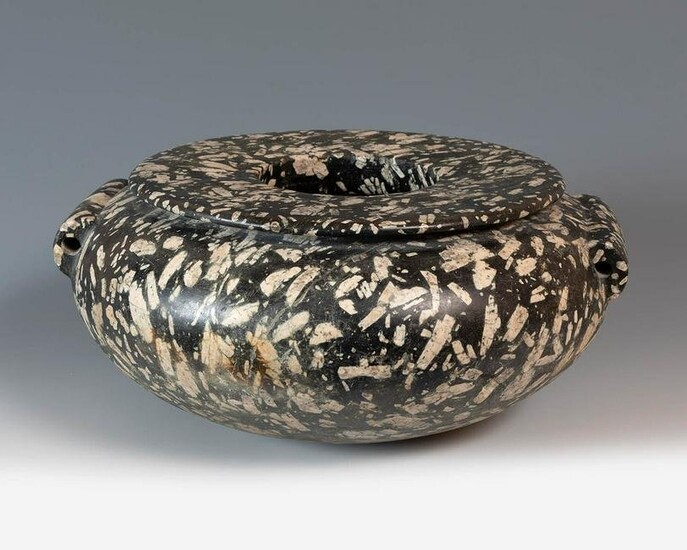Round-bottomed spherical jar; Ancient Egypt, End of the
Globular vase; Ancient Egypt, Late Predynastic - Early Tinite Period, 3100 - 2900 BC.
Porphyritic stone, Diorite.
With professionally restored fissure lines.
Provenance: Private collection N. D., Brussels, Belgium. Purchased from Mr. R. E. bought before 1980, Brussels, Belgium.
Measurements: 13.5 x 32 cm (diameter).
A globular-bodied vase with a perfectly rounded bottom, carved from a single block of black diorite, with a simple and elegant design. The circular upper opening has a wide, flat lip and a wide, low neck. The handles, like cylindrical ears, are pierced on both sides and are placed opposite each other on the shoulder of the vessel. The interior is well hollowed out, conforms to the outer contour and is unpolished, leaving multiple horizontal grooves, with tool marks visible. Before being carved in different types of stone, these vessels were made in similar forms in terracotta by Egyptian potters. In particular, this form appears in the Nagada II period, when they were decorated with wavy lines and spirals in reddish tones.
In ancient Egypt, stone vessels were considered luxury items, appearing only in royal tombs and the highest ranking tombs. Chronologically, they appear at the beginning of the 3rd millennium BC, and are most prevalent at the end of the 2nd Dynasty. The art of carving stone vessels reached its peak as far back as the Early Dynastic period and the Old Kingdom. Stone vessels were mainly used to contain foodstuffs, ointments and cosmetic oils. Thanks to the thickness and impermeability of their walls, they allowed for good preservation of the products. They had many uses in everyday life, but also played a prominent role in religious activities; offerings in temples, daily anointing of statues and cult objects, and in the funerary world, for the preparation of mummies, as well as in the belief in the rejuvenating and regenerating effect of these substances. It is therefore not surprising that a large number of stone vessels were regularly deposited in tombs and burial complexes.
Estimate
Time, Location
Auction House
Globular vase; Ancient Egypt, Late Predynastic - Early Tinite Period, 3100 - 2900 BC.
Porphyritic stone, Diorite.
With professionally restored fissure lines.
Provenance: Private collection N. D., Brussels, Belgium. Purchased from Mr. R. E. bought before 1980, Brussels, Belgium.
Measurements: 13.5 x 32 cm (diameter).
A globular-bodied vase with a perfectly rounded bottom, carved from a single block of black diorite, with a simple and elegant design. The circular upper opening has a wide, flat lip and a wide, low neck. The handles, like cylindrical ears, are pierced on both sides and are placed opposite each other on the shoulder of the vessel. The interior is well hollowed out, conforms to the outer contour and is unpolished, leaving multiple horizontal grooves, with tool marks visible. Before being carved in different types of stone, these vessels were made in similar forms in terracotta by Egyptian potters. In particular, this form appears in the Nagada II period, when they were decorated with wavy lines and spirals in reddish tones.
In ancient Egypt, stone vessels were considered luxury items, appearing only in royal tombs and the highest ranking tombs. Chronologically, they appear at the beginning of the 3rd millennium BC, and are most prevalent at the end of the 2nd Dynasty. The art of carving stone vessels reached its peak as far back as the Early Dynastic period and the Old Kingdom. Stone vessels were mainly used to contain foodstuffs, ointments and cosmetic oils. Thanks to the thickness and impermeability of their walls, they allowed for good preservation of the products. They had many uses in everyday life, but also played a prominent role in religious activities; offerings in temples, daily anointing of statues and cult objects, and in the funerary world, for the preparation of mummies, as well as in the belief in the rejuvenating and regenerating effect of these substances. It is therefore not surprising that a large number of stone vessels were regularly deposited in tombs and burial complexes.



